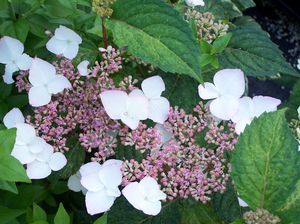View All Plants :: View All DECIDUOUS SHRUBS
Hydrangea serrata 'Omacha Variegata'
Lace Cap Hydrangea
Plant Type:
DECIDUOUS SHRUBSHydrangea serrata 'Omacha Variegata' - All leaves emerge quite gold with a fine red margin. Leaves mature heavily mottled with gold with concentrations trending more at the leaf centers, the edges displaying more green. The fine central vein is red from the petiole part way towards the sharply tipped obovate leaves; lots of red shows in the newest not-yet-hardened wood, too. Summer lace cap flowers will be blue in acid Ph soil, pink in alkaline. Site in full to part sun in fertile soil. For gardeners towards the northern end of its range spring planting is advised. Established potted Mountain Hydrangea, cutting grown.
More About Hydrangea serrata 'Omacha Variegata'
- Beautiful Variegated Leaves
Characteristics and Attributes for Hydrangea serrata 'Omacha Variegata'
Season of Interest (Flowering)
- Summer / Autumn
Season of Interest (Foliage)
- Spring / Summer / Autumn
Autumn Interest
- Autumn Leaf Color
Nature Attraction
- Deer Resistant
Light
- Mostly Sunny
- Full Sun
Attributes
- Border
- Shrub Border
- Specimen
- Hedge
- Hedgerow
- Foundation
Growth Rate in the Garden
- Moderately Fast
Soil
- Fertile
- Sandy
- Acid
- Draining
- Calcareous
Origins
- Garden Origin
Propagated By
- Cutting Grown
Genus Overview: Hydrangea serrata
This species originates in the mountains of Japan and Korea. Though it is purportedly hardier than H. macrophylla we seldom see flowers in USDA zone 5b; as such we are listing all of the following cultivars as better doers in zones 6 to 9. The ovate to lanceolate foliage tends to be narrower than its close cousin, H. macrophylla. The smaller leaves support an over all more delicate appearance. And as with H. macrophylla there are also both lace caps and mop heads occurring in this species and will be noted below. We've seen this group also listed as H. macrophylla var. serrata. All prefer fertile soil to sandy loam. All of the following cultivars are cutting grown.


